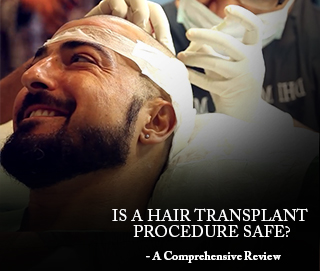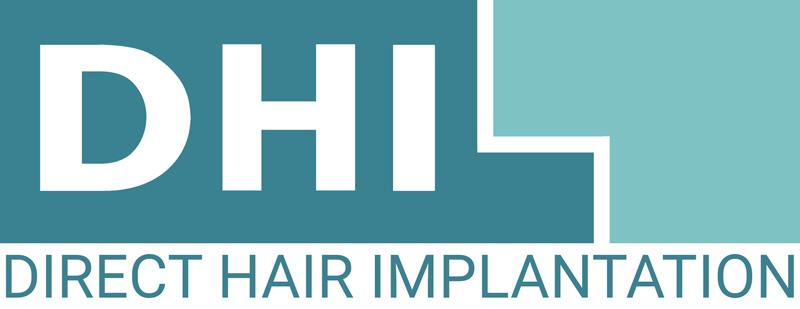Is a Hair Transplant Procedure Safe?

In most developed and developing countries, hair transplant is the most common cosmetic treatment undergone by men. As per a recent estimation by ISHRS, more than 700,000 hair restoration treatments were performed globally in the year 2021.
The fact clearly indicates that hair loss is a common problem shared by people from various different countries. The only permanent solution, of course, is a hair transplant procedure.
But many people are still dubious about trying it out. All because they have one important question in their minds – is hair transplant safe?
In this article, we shall explore the risks associated with hair transplant procedures, their potential side effects, and the best practices to avoid said complications.
Is Hair Transplant Safe?
Yes, most hair transplant procedures are safe and minimize the risk of complications. However, this is only true if the treatment is performed by a trained specialist with appropriate credentials.
In many cases, many clinics adopt more lenient practices. It’s not uncommon for establishments to entrust underqualified lab technicians with the responsibility of leading the hair transplant procedure. Many medical experts and hair restoration specialists have strongly advised against using anyone but a qualified individual with the relevant educational background to oversee a complicated cosmetic procedure like hair transplantation.
So, is a hair transplant safe if it’s performed by a qualified surgeon? Yes, any hair restoration procedure has little to no postoperative side effects. However, there might be some degree of complications, as is normally the case with any form of cosmetic procedure or surgery.
At DHI, we use state-of-the-art, patented techniques that help our specialists carry out the operation smoothly and minimize the risk of post-operation complications. To give you further insight, let’s discuss the type of hair transplant procedures adopted by different clinics.
Most Important Types of Hair Transplant Techniques
There are three major techniques of carrying out a hair transplant treatment
- Direct Hair Implantation (DHITM): Direct hair implantation is the most advanced technique used to restore hair growth in individuals experiencing baldness. Unlike traditional hair transplantation methods, which involve the removal of a strip of skin from the donor area, direct hair implantation is a minimally invasive procedure. It involves extracting individual hair follicles from the donor area and directly implanting them into the recipient area using specialized tools. This approach ensures a more natural-looking result with minimal scarring and faster recovery time. Direct hair implantation offers a highly precise and efficient solution for individuals seeking a permanent solution to their hair loss concerns, providing them with a chance to regain their self-confidence and achieve a fuller head of hair.
- Follicular Unit Extraction (FUE): FUE is characterized by the removal of hair follicles from the donor site using proprietary punch tools. The extracted follicles are then transplanted to the recipient site, leaving little to no scars.
- Follicular Unit Transplantation (FUT): FUT is characterized by the removal of a strip of skin from the patient’s scalp. The dissected portion is then divided into smaller grafts comprising one to four hair follicles each. The retrieved grafts can then be safely transplanted to the recipient site. The area from where the strip was removed is sutured close.
Which Method is Safer?
Both FUT and FUE hair restoration methods have their own merits and shortcomings. But in terms of safety, the Direct Hair Implantation (DHITM) technique takes the cake. It is a less invasive procedure and leaves only minimal scarring.
The FUT method leaves a large strip of a scar where the skin is sutured close. On the other hand, FUE is a complicated procedure. Another disadvantage of FUE is that it is not fit for patients who require a larger number of grafts for their hair transplant treatment.
DHI allows for the precise placement of individual hair follicles, leading to the natural growth of your hair. The hair is implanted at the correct angle, direction, and depth, resulting in a more natural-looking hairline and overall hair density.
As already mentioned, the hair transplant from the DHITM technique is a minimally invasive procedure compared to other hair transplantation techniques. It uses a specialized tool called a DHI Implanter pen, which creates tiny incisions for implantation without the need for creating recipient site incisions beforehand. This reduces the risk of scarring and promotes faster healing. With DHI Implanter, our surgeon has complete control over the angle, depth, and direction of the implanted hair, making it the safest method.
At DHI clinics, you can enjoy a safe hair transplant procedure of up to 6,000 to 8,000 hairs in a single session. In terms of safety, Direct Hair Implantation should definitely be your top priority.
Risks Associated with Hair Transplantation
While hair restoration processes are generally safe, they do not come without any risks. There might be some complications that you might face following the operation.
Some of the common ones are:
- Infection spreads
- Pain or discomfort at the site of the surgery
- Swelling of the forehead or the follicles
- Bleeding from the surgery site
- Continued hair loss months after the completion of the transplant process
If you experience any of the symptoms listed above, you should seek immediate medical attention from the clinic where the transplantation procedure was completed. However, it’s best to look for prevention techniques rather than a cure. So, let’s move on to our next section.
Best Practices to Minimize Complications After a Hair Transplant Procedure
While it may not always be in your hand, you can try out some helpful techniques to minimize health-related problems and complications following a hair transplant surgery.
Here’s what you can do:
1. Take Post-Operative Care
Following the procedure, your hair restoration specialist will provide you with a list of instructions that you need to follow. This may include information on how to take care of the transplanted area, what kind of hair products you should use, and what activities you need to avoid for a certain period of time.
2. Follow the Prescribed Medication Pattern Diligently
Your hair transplant specialist will likely put you on medication to manage pain, reduce inflammation, and prevent infection in the healing site. Make sure that you follow the instructions diligently and don’t miss out on any of the prescribed medicines.
3. Leave the Transplanted Area Alone
The transplanted area is likely going to itch following the procedure. You’ll often feel the urge to scratch it away or at least rub it gently. Unfortunately, you cannot give in to the urge. Any form of contact with the transplanted area should be avoided as it can severely disrupt the healing process.
4. Avoid Sunlight Exposure
Heat and sunlight can increase the risk of swelling or damage to the transplanted area. So, you must avoid it for a certain period (as instructed by the surgeon). You can wear a hat or other protective equipment during this phase.
5. Attend Follow-Up Appointments
Make sure that you are present at all the follow-up appointments without delay. The surgeon will observe your healing progress and see if everything is going as expected. If you miss out on any of these appointments, any kind of complication may go unnoticed.
Debunking Five Common Myths About Hair Transplant Procedures
There are several myths and misconceptions related to hair transplant procedures. Let’s debunk some of them:
Myth 1: Transplanted Hairs Look Fake and Unnatural
Fact: Modern hair transplants can replicate natural hair strands to perfection. Techniques like Direct Hair Implantation carried out at our clinics guarantee high precision as it can even predict the direction and the placement of the hair follicles implanted.
Myth 2: Hair Transplants Are Painful and Require Long Recovery Time
Fact: While there are some side effects to hair transplant procedures, like discomfort, itching, or swelling, the complications are normal. Moreover, recovery time is negligible. Most patients are able to return to their regular schedules after only a few days or a week following the surgery.
Myth 3: Hair Transplants Only Work Well for Men
Fact: Although the causes of hair loss are very different for men and women, hair transplant procedures can work effectively for both.
Myth 4: Hair Transplants Only Work for Certain Types of Hair Loss
Fact: Hair restoration procedures are very common and can be used to treat various conditions that might be causing hair loss in both men and women. Some of these conditions include male pattern baldness, female pattern hair loss, scarring alopecia, and so on.
Myth 5: Hair Transplants are Prohibitively Expensive
Fact: With techniques like DHI – Direct Hair Implantation revolutionizing the industry, hair transplant procedures no longer require astronomical investments. There are certain financial plans and payment options available that can accommodate different kinds of budgets and make the procedure more affordable and accessible to everyone.
Parting Words
Many people who are attracted to the idea of getting a hair transplant treatment never try it out because they think it’s unsafe. However, if you follow all the precautions and instructions, you’ll hardly face any complications or side effects.
At Direct Hair Implantation, India, we have a customer satisfaction rate of around 99%, a figure that is way beyond the industry average. This fact indicates that we use procedures that minimize scarring, reduce the risk of side effects, and require minimal recovery time.
At DHI, India we guarantee completely natural outcomes, as we provide precise control over the depth, angle, and direction of the hair implantation process. To ensure transparency and accuracy, each customer is given a picture of the graft tray and card, allowing them to count the exact number of implanted hairs. The graft stacking in the tray facilitates easy counting. A photo is taken alongside the Graft Tray card and shared with the customer for verification. If you want to experience a safe, hassle-free, and medically superior hair transplant procedure, contact Direct Hair Implantation – DHI clinics for more information.
